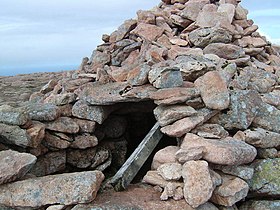Ronas Hill
| Ronas Hill | |
|---|---|

The chambered cairn on the summit of Ronas Hill
|
|
| Highest point | |
| Elevation | 450 m (1,480 ft) |
| Prominence | 450 m (1,480 ft) |
| Listing | Marilyn |
| Coordinates | 60°32′02″N 1°26′46″W / 60.53393°N 1.44605°WCoordinates: 60°32′02″N 1°26′46″W / 60.53393°N 1.44605°W |
| Naming | |
| Translation | stony ground or scree (Norse) |
| Geography | |
| Location | Shetland, Scotland |
| OS grid | HU305835 |
| Topo map |
OS Landranger 3 |
| Official name | Ronas Hill-North Roe & Tingon |
| Designated | 11 August 1997 |
OS Landranger 3
Ronas Hill (or Rönies Hill) (450m) is a Marilyn, the highest point of Mainland, Shetland, in Scotland. There is a Neolithic chambered cairn near the summit.
Ronas Hill (Old Norse: rön, meaning stony ground or scree) is on the Northmavine peninsula of Mainland, Shetland, at HU305835. The Norse name certainly describes the hilltop. It is the highest point on the entire Shetland archipelago. On a clear day, much of Shetland can be seen from the summit. It looks over Yell Sound, the North Sea, across to the Atlantic Ocean and even the highest points of Fair Isle.
Ronas Hill is a Ramsar site, containing many rare Arctic plants. Peculiarly for Shetland, there are several species of woodland fungi, notably ceps and chanterelles, which normally grow on the roots of deciduous trees (notable by their absence on Ronas Hill). Here, they are associated with creeping willow, which grows extensively on the hill.
On top of the hill, there is a Neolithic chambered cairn, unusual for its position on top of a hill. Most surviving Neolithic British cairns are sited in prominent places, but not generally on the top of taller hills. According to local farmers, until the construction of Sullom Voe Terminal in the mid-1970s, the cairn contained a variety of "sacrifice" items, such as coins (some "very old") and other items. Before that time, Ronas Hill would have been far off the beaten track.
...
Wikipedia
